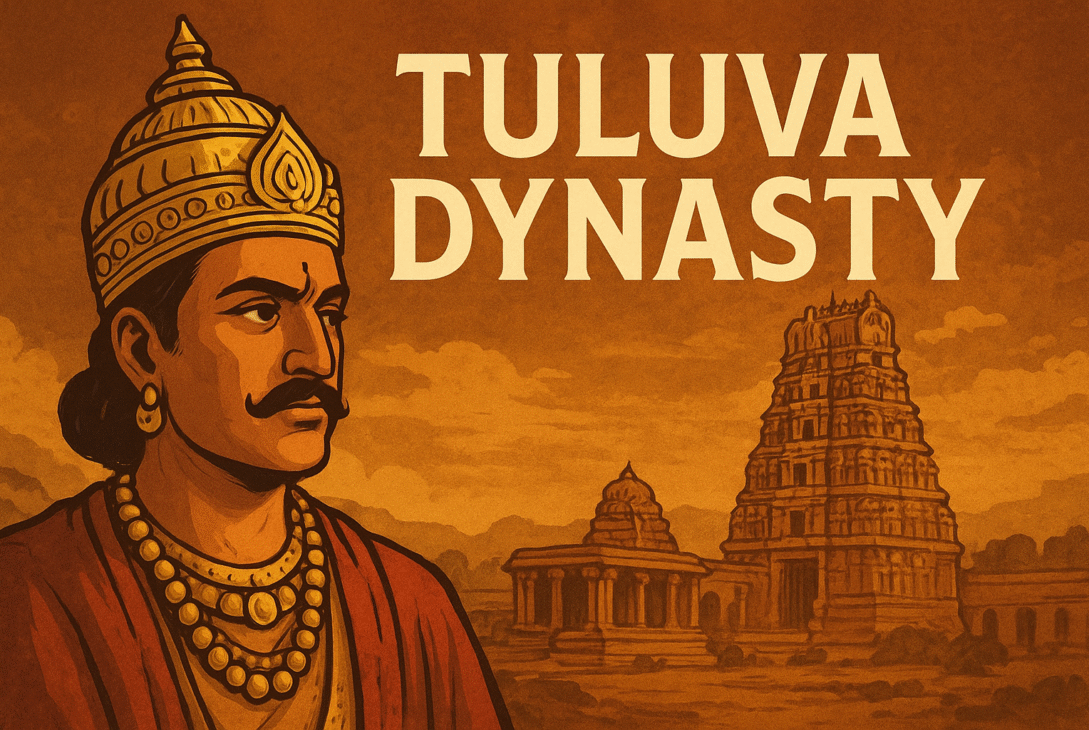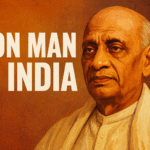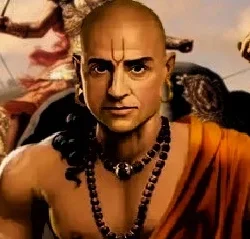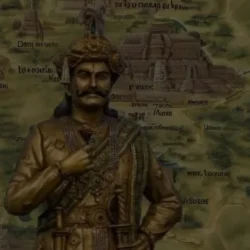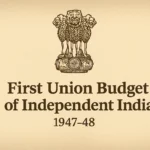Introduction
The Tuluva Dynasty marked the most resplendent and transformative phase in the history of the Vijayanagara Empire. Emerging from the turbulence of the Saluva line’s decline, the Tuluvas revived the empire’s grandeur and stability through military prowess, administrative brilliance, and unparalleled cultural patronage. Under their rule—especially that of Krishnadevaraya—Vijayanagara rose to become the beacon of South Indian civilization, blending power with prosperity, faith with tolerance, and art with statecraft.
The dynasty’s story begins with Veera Narasimha, a ruler who secured the throne through blood and turmoil, and reaches its zenith under Krishnadevaraya—the architect of the empire’s golden age. From there, through the troubled reigns of Achyutaraya and Venkata I, and finally to the tragic fall under Sadasiva Raya and his regent Rama Raya at the Battle of Talikota, the saga of the Tuluva line mirrors the rise and fall of South India’s last great imperial power.
Rise of the Tuluva Dynasty
The founder of the Tuluva line, Veera Narasimha (1503–1509), also known as Immadi Narasa Nayaka, rose to power through intrigue and ambition. As the regent of the Vijayanagara Empire, he eliminated his rival, the legitimate heir Immadi Narasimha, by orchestrating his assassination at Penukonda in 1505 CE, and soon ascended the throne himself. His six-year reign was marked by the suppression of widespread rebellions and external threats that had plagued the empire following the decline of the Saluva.
During this period, Yusuf Adil Khan of Bijapur, seeking to exploit Vijayanagara’s internal chaos, allied with the Adavani chieftain Kashappa Odeya and invaded the empire, laying siege to Kurnool (Kandanavolu). However, Rama Raya of the Aravidu family and his son Timma came to Veera Narasimha’s aid, defeating Adil Khan and reclaiming Adavani. As a gesture of gratitude, the emperor granted Kurnool and Adavani as fiefs to the Aravidu rulers.
Veera Narasimha then turned his attention to the suppression of revolts in Karnataka and the Tulu regions. Leaving his half-brother Krishnadevaraya in charge of the capital, he marched against Umattur and later Srirangapatna. Despite a prolonged siege of three months, he failed to subdue Umattur and suffered reverses at Srirangapatna and Talakad, though his coastal campaign along the western seaboard proved successful, extending his control over Tamil coastal ports.
To strengthen the army, he reformed the cavalry by purchasing fine horses from Portuguese traders and recruited competent soldiers regardless of caste or creed. To encourage valor, he organized frequent duels among soldiers, rewarding the victors with gifts and instilling in them the belief that cowardice was shameful. His interest in agrarian welfare was reflected in tax remissions, such as abolishing the marriage tax in certain regions. A devout patron of religion, he made generous donations to temples at Rameshwaram, Srirangam, Kumbakonam, Chidambaram, Srisailam, Kanchipuram, Kalahasti, Mahanandi, and Gokarna.
In 1509 CE, Veera Narasimha passed away, leaving behind a turbulent but stabilized realm—and the path was clear for the rise of his brilliant successor, Krishnadevaraya.
Krishnadevaraya — The Architect of Empire
Wars and Victories
Krishnadevaraya (1509–1529), son of Narasa Nayaka and Nagaladevi, was one of India’s greatest monarchs. Ascending the throne on August 8, 1509, the auspicious day of Janmashtami, he assumed the imperial title Maharajadhiraja Rajaparamēśvara Veera Bhujabala Pratapa Krishnadevaraya Mahārāya.
At the time of his accession, Vijayanagara faced threats from all sides—rebellious vassals, the Gajapati king of Orissa, the Bijapur Sultan Yusuf Adil Khan, and the rising Portuguese power on the west coast. Yet, through sheer courage, strategy, and discipline, Krishnadevaraya transformed these threats into triumphs.
In 1509, Muhammad Shah of the Bahmani remnants declared jihad against Vijayanagara, but Krishnadevaraya’s forces crushed the invaders near Doani, wounding the Sultan and routing his army. Pursuing the retreating forces, the king killed Yusuf Adil Khan in the Battle of Kovilkonda, capturing the fortress and destabilizing Bijapur. By 1512, he had besieged and captured Raichur, followed by Gulbarga, defeating Barid-i-Mamalik and taking Bidar under Vijayanagara’s control. These victories earned him the titles Yavanarajya Sthapanacharya and Ashtadikraja Manobhayaṁkara.
Krishnadevaraya next turned against Gangaraya of Ummattur, a defiant vassal. After year-long sieges at Srirangapatna and Shivanasamudra, the rebel drowned in the Kaveri while fleeing, and his territories were annexed.
Then, seeking to reclaim Udayagiri and Kondavidu, which had been lost to the Gajapatis, he launched a campaign in 1513. After a prolonged siege, Udayagiri fell. Marching further north, he crushed the Gajapati resistance at Kondavidu and captured their prince, Veerabhadra, and a royal queen. By 1516, Krishnadevaraya had reached Rajahmundry, defeated Gajapati Prataparudra, and erected a victory pillar on the banks of the Krishna River. The humbled Gajapati sued for peace in 1518, marrying his daughter to Krishnadevaraya and ceding lands north of the Krishna.
The emperor’s triumphs continued in the west and north, where he subdued Golconda’s Quli Qutb Shah, drove him from Panagal and Guntur, and restored order. In 1520, when Ismail Adil Khan of Bijapur recaptured Raichur, Krishnadevaraya personally led a massive force—nearly 10 lakh infantry and 500 elephants—into battle. Assisted by Portuguese artillery, he reclaimed Raichur after a fierce engagement on May 19, 1520, forcing the Sultan to flee and honoring the Portuguese with rich gifts.
Administration and Reforms
Krishnadevaraya was not only a conqueror but also a master administrator. He frequently toured his empire, ensuring justice and prosperity. He improved irrigation through tanks and canals, abolished burdensome taxes like the marriage levy, and expanded cultivable land by clearing forests.
He founded the city of Nagallapur (modern Hospet) in memory of his mother and adorned Vijayanagara with magnificent temples, thousand-pillared halls, and towering rayagopurams. Drawing from the Arthashastra and Manusmriti, he ruled through a well-advised council led by the capable Salva Timmarasa. Other notable ministers included Kondamarasa, Rayasam Ayyapparasa, and Ramabhattayya. His council met in the royal assembly hall, Bhuvana Vijayam, a seat of both governance and learning.
Patron of Arts and Culture
Culturally, Krishnadevaraya’s court glittered with literary and artistic genius. The famed Ashtadiggajas, eight great Telugu poets, graced his court—among them Allasani Peddana, Nandi Timmanna, and Tenali Ramakrishna. Krishnadevaraya himself was a poet, authoring Amuktamalyada in Telugu and Jambavati Kalyanam in Sanskrit.
Kannada scholars like Vidyānanda and Gubbiyamallanaarya, and poets like Nanjunda (author of Kumararama Charite), flourished under his patronage. His reign also nurtured saint-composers like Vyasatirtha, Purandara Dasa, and Kanaka Dasa, who laid the foundations of Carnatic music and Dasa Sahitya.
A devout Vaishnava yet tolerant ruler, Krishnadevaraya revered Venkateshwara of Tirupati and installed the idol of Bala Krishna brought from Udayagiri at Vijayanagara. He donated lavishly to temples across South India, from Srisailam to Kalahasti, and held his royal preceptor Sri Vyasaraya in the highest esteem.
Character and Legacy
Foreign travelers such as the Portuguese Domingo Paes (1522) described Krishnadevaraya as a “perfect monarch—brave, just, cheerful, and magnanimous.” His compassion, valor, and devotion earned him the adoration of his soldiers and subjects alike. Yet, he was not without flaws—his temper led him to harsh acts, such as blinding his minister Timmarasa under suspicion and demanding that Adil Khan kiss his feet in submission.
Despite such human failings, Krishnadevaraya stands as the epitome of South Indian kingship—valiant in war, wise in governance, and generous in spirit. In 1529, gravely ill, he declared his brother Achyutaraya as his successor and passed away, leaving behind an empire unmatched in splendor.
Achyutaraya and the Struggles for Stability (1529–1542)
Achyutaraya, brother of Krishnadevaraya and son of Narasa Nayaka by Obambike, ascended a throne shadowed by intrigue. His accession was contested by Rama Raya, Krishnadevaraya’s son-in-law, leading to initial conflict. Achyuta defeated Rama Raya but soon faced a wave of rebellions and invasions.
Ismail Adil Khan recaptured Raichur and Mudgal, while Gajapati rulers and the Golconda Sultan tested the empire’s strength. Achyutaraya compromised by sharing authority with Rama Raya, but internal dissent persisted. The rebellious Salva Narasimha, allied with Umattur and Tiruvadi, was defeated near the Tamraparni River, where Achyuta erected a victory pillar and reinstated the Pandya ruler, earning the Pandyan princess’s hand in marriage.
He later subdued Gooty’s chieftain and extended the frontier up to the Krishna River. Yet, political instability continued—Rama Raya seized power in the emperor’s absence but was soon overthrown by loyal nobles. The turbulence invited opportunistic raids by Ibrahim Adil Shah, who ravaged Nagalapur, and by Ahmadnagar’s Sultan, who attacked Bijapur. Eventually, a compromise restored Achyutaraya’s authority while granting Rama Raya semi-autonomous control.
Achyutaraya’s reign, though marked by turmoil, preserved the empire’s territorial integrity. The Sanskrit poet Rajanatha Dindima celebrated his life in Achyuta Ramabhudaya. He died in 1542, leaving his son Venkata I as successor.
Venkata I and the Era of Intrigue (1542–1543)
Upon Achyuta’s death, Venkata I ascended the throne as a child, with his maternal uncle Salakaraju Tirumala acting as regent. Tirumala’s ambition soon aroused suspicion, and Achyuta’s widow Varada Devi sought Adil Khan’s aid. Sensing danger, Tirumala lured Adil Khan into an alliance, while Rama Raya—still a powerful noble—freed Sadasiva, a prince of royal blood, and declared him the rightful emperor.
A chaotic civil war ensued. Adil Khan invaded Vijayanagara but was repelled by Tirumala’s forces. Yet Tirumala’s tyranny alienated the nobles, who appealed to the Sultan for intervention. Adil Khan returned briefly but withdrew amid hostility from the populace. Seizing the moment, Rama Raya defeated and killed Tirumala in battle near the Tungabhadra and enthroned Sadasiva Raya (1543–1571) as nominal ruler.
Sadasiva Raya and Rama Raya — The Final Days

Although Sadasiva Raya held the title of emperor, actual power lay with Aliya Rama Raya, the brilliant but imperious statesman who ruled as de facto sovereign. Initially, he stabilized the realm, reasserted authority over rebellious governors, and extended influence over the western coast, Travancore, and even Sri Lanka.
Rama Raya’s general Vittala subdued Tiruvadi and Thirunelveli, securing annual tribute agreements. When these were broken, he re-invaded in 1558, suffering heavy losses but retaining dominance. Relations with the Portuguese fluctuated—sometimes hostile, sometimes cooperative. In 1547, Rama Raya signed a friendship treaty with the Portuguese at Goa, even permitting them control over Salcete and Bardez in exchange for military support.
Rama Raya skillfully exploited the rivalries among the Deccan Sultanates, often allying with one against another—a policy that won him short-term gains but sowed seeds of disaster. Between 1544 and 1560, he alternately fought and allied with Bijapur, Ahmadnagar, Golconda, and Bidar, gaining titles like Kalyana Puravaradhishvara after capturing Kalyana from Ibrahim Adil Shah. He installed friendly rulers, mediated successions, and maintained Vijayanagara’s supremacy in the Deccan for two decades.
However, his arrogance, interference in Deccan politics, and condescending treatment of the Muslim Sultans bred resentment. By 1564, under Ali Adil Shah of Bijapur, the rulers of Ahmadnagar (Husain Nizam Shah), Golconda (Ibrahim Qutb Shah), and Bidar (Ali Barid Shah) formed a grand confederacy to crush Vijayanagara. The pretext was Adil Shah’s demand for the return of Raichur and Mudgal, which Rama Raya contemptuously refused.
The Cataclysmic Fall and Enduring Legacy
On January 25, 1565, the armies met at Talikota (also called the Battle of Rakkasatangadi). Rama Raya, then nearly eighty, led Vijayanagara’s 70,000 cavalry and 90,000 infantry against the combined Muslim forces. Initially, the imperial army prevailed—commanders Tirumala and Venkata routed the enemy flanks, but betrayal struck at the heart of the formation. Two Muslim generals within Vijayanagara’s ranks defected mid-battle, causing confusion.
Rama Raya, fighting valiantly, was captured and beheaded by Husain Nizam Shah. His severed head, raised on a spear, broke the morale of his troops. The once-invincible Vijayanagara army scattered in panic. The fleeing princes Tirumala and Venkata retreated toward Chandragiri, carrying the royal family and treasures—over 1,500 elephants laden with gold and jewels.
The victorious Sultanate armies entered Vijayanagara, unleashing six months of unrestrained plunder and destruction. Palaces burned, temples were desecrated, and priceless works of art vanished. As chronicler Robert Sewell later wrote, “a city once rich and radiant became a heap of ruins such as the world has seldom seen.”
Tirumala later reassembled remnants of the empire, shifting the capital to Penukonda and then Chandragiri, but the age of Vijayanagara’s grandeur had ended forever.
Conclusion
The story of the Tuluva Dynasty is the story of Vijayanagara’s greatest triumph and most tragic fall. From Veera Narasimha’s consolidation to Krishnadevaraya’s brilliance, from Achyutaraya’s turbulence to Rama Raya’s ambition, the dynasty embodied the full spectrum of imperial destiny—valor, prosperity, pride, and ruin.
Its legacy, however, outlived its fall. The temples of Hampi, the music of Purandara Dasa, and the poetry of Krishnadevaraya continue to echo the cultural spirit of South India.
The Tuluva Dynasty’s brilliance and tragedy remind us that every empire’s grandeur carries within it the seeds of its own decline.
